Kultur in Gefahr - ITI
Kultur in Gefahr - ITI
Kultur in Gefahr - ITI
You also want an ePaper? Increase the reach of your titles
YUMPU automatically turns print PDFs into web optimized ePapers that Google loves.
70 Artistic Expression <strong>in</strong> a Corporate World<br />
Artistic Expression <strong>in</strong> a Corporate World 71<br />
is no reason to treat the digital world any differently from the world we<br />
know thus far. The fact is that strong violent imag<strong>in</strong>ations construct the<br />
moral make-up of viewers and users, and also that of games, and this<br />
<strong>in</strong>fluences <strong>in</strong>directly their day-to-day behaviour. Not only are regulations<br />
desirable from this perspective, but also because of the immanent threat<br />
for diversity as a consequence of market developments. Actually, the field<br />
of games is very much conglomerated. There are three major <strong>in</strong>dustrial<br />
players who dom<strong>in</strong>ate the market, and it is not <strong>in</strong>conceivable that this<br />
number will be reduced to two <strong>in</strong> the near future. Of course, there are many<br />
others who are try<strong>in</strong>g to f<strong>in</strong>d a place under the digital sun, but they are<br />
pushed away more and more from public attention by the omnipresence of<br />
the big three.<br />
What to do? Where is the access for regulations? There is an<br />
urgent need for public authorities to support, with subsidies and other<br />
facilities, the production of a great diversity of games. Otherwise this<br />
<strong>in</strong>terest<strong>in</strong>g <strong>in</strong>teractive cultural field will be left to a couple of dom<strong>in</strong>ant<br />
market forces. On the side of outlets the question is less easy to answer.<br />
Actually, there are two equally important <strong>in</strong>stances of distribution.<br />
Potential players buy a game <strong>in</strong> a shop, then adapt it to their requirements<br />
on the <strong>in</strong>ternet and pay there a second time accord<strong>in</strong>gly. To regulate the<br />
<strong>in</strong>ternet <strong>in</strong> this field, as <strong>in</strong> the digital examples given up here by Garry Neil<br />
would not make sense. Players, who have bought a game <strong>in</strong> a shop will<br />
steer their mouse straightforwardly to the site of the company from which<br />
they have bought the game. Would this then mean that the only rema<strong>in</strong><strong>in</strong>g<br />
start<strong>in</strong>g-po<strong>in</strong>t for regulat<strong>in</strong>g is the shop? Until now we have tried to avoid<br />
tak<strong>in</strong>g shops as the po<strong>in</strong>t of regulation, because <strong>in</strong> the case of publish<strong>in</strong>g,<br />
it would prove difficult to get a grip on the stock <strong>in</strong> shops. In the case of<br />
games, one can buy them <strong>in</strong> a number of different outlets. Gett<strong>in</strong>g a grip on<br />
them is nearly a mission impossible; a limited number of outlets are<br />
relatively easier to regulate, monitor and assess than dispersed ones. So,<br />
the question how to regulate the distribution of games stays, thus far,<br />
unanswered, but is nevertheless relevant.<br />
(b) After this exposé on the at least variable content regulations, the<br />
second option of content regulations is the must carry system, that might<br />
also be called the essential facility doctr<strong>in</strong>e under US law that says that an<br />
enterprise that controls a specific channel of communication must open it<br />
up to more suppliers than just the owner of the essential facility (Germann<br />
2003: 121). This approach requires monopolists or dom<strong>in</strong>ant players on the<br />
cultural market to give third-party access to rivals on terms that are fair<br />
and non-discrim<strong>in</strong>atory. (Doyle 2002: 169). If a cultural enterprise <strong>in</strong> the<br />
field of production, distribution or promotion (or all of them at the same<br />
time) is very strongly present on the cultural market (at the moment this<br />
cannot be avoided) then it should get a public task to fulfil. This will<br />
ensure that cultural diversity cont<strong>in</strong>ues to exist, despite the market<br />
dom<strong>in</strong>ant position of this specific enterprise. The public task is to be the<br />
carrier of diversity without <strong>in</strong>terfer<strong>in</strong>g editorially or otherwise <strong>in</strong> the artistic<br />
choice of what selected <strong>in</strong>dependent producers and distributors wish to<br />
offer to the public.<br />
The must carry system is a crucial one because it regulates that<br />
access to all different k<strong>in</strong>ds of content is available and possible.<br />
Obviously, all the social and cultural objectives of other regulations <strong>in</strong><br />
favour of cultural diversity through such mechanisms as quotas,<br />
subsidies, tax systems and so on could not be met if viewers or listeners<br />
cannot f<strong>in</strong>d access to this content.<br />
(c) Maybe one of the most challeng<strong>in</strong>g forms of content regulations is<br />
the system clearly def<strong>in</strong><strong>in</strong>g that cultural products from one foreign country<br />
may not have a market share larger than, for example, ten, twenty or twenty<br />
five per cent. One may call this the no more than alternative. It limits the<br />
market share. This is an attractive form because it keeps the cultural market<br />
open for cultural creations from everywhere <strong>in</strong> the world. However, there<br />
should not be one foreign source that overwhelms local cultural life<br />
substantially. The basic pr<strong>in</strong>ciple here is that: this regulation is not about<br />
exclusion, but does make sure that there is space for the presentation of a<br />
wide range of diverse cultural options.<br />
For <strong>in</strong>stance, <strong>in</strong> South Korea the Broadcast<strong>in</strong>g Act limits foreign<br />
content to 20 per cent for terrestrial channels, 30 per cent for cable<br />
channels, or up to 50 per cent if the cable programs concern technology<br />
and science, culture, or sports. However, Daeho Kim and Seok-Keyong<br />
Hong remark that the ratio of foreign content does not even reach this<br />
level. ‘Thus, it can be said that the quota is a normative l<strong>in</strong>e rather than a<br />
practical restra<strong>in</strong>t.’ (Kim 2001: 79).<br />
The no more than alternative is not directed aga<strong>in</strong>st one specific<br />
country, or any specific cultural enterprise. It just signals that foreign<br />
content, or productions com<strong>in</strong>g from one other s<strong>in</strong>gle source, have a too<br />
dom<strong>in</strong>ant presence on the local cultural market and push aside the variety


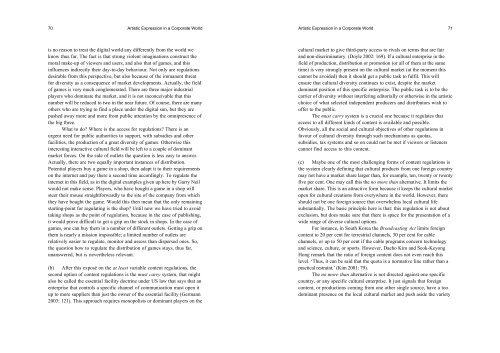
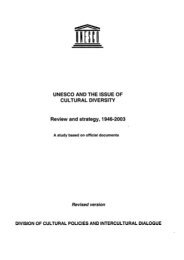
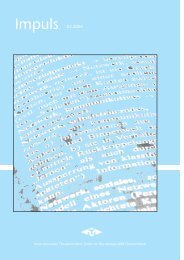
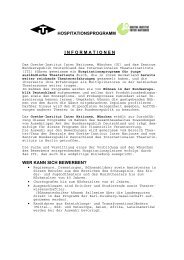

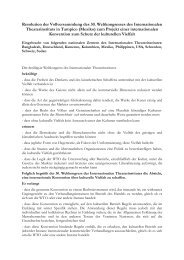
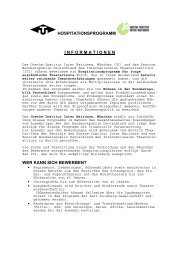
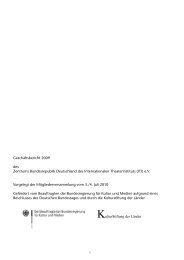
![Geschäftsbericht 2010 [pdf 2 MB] - ITI](https://img.yumpu.com/4380475/1/184x260/geschaftsbericht-2010-pdf-2-mb-iti.jpg?quality=85)